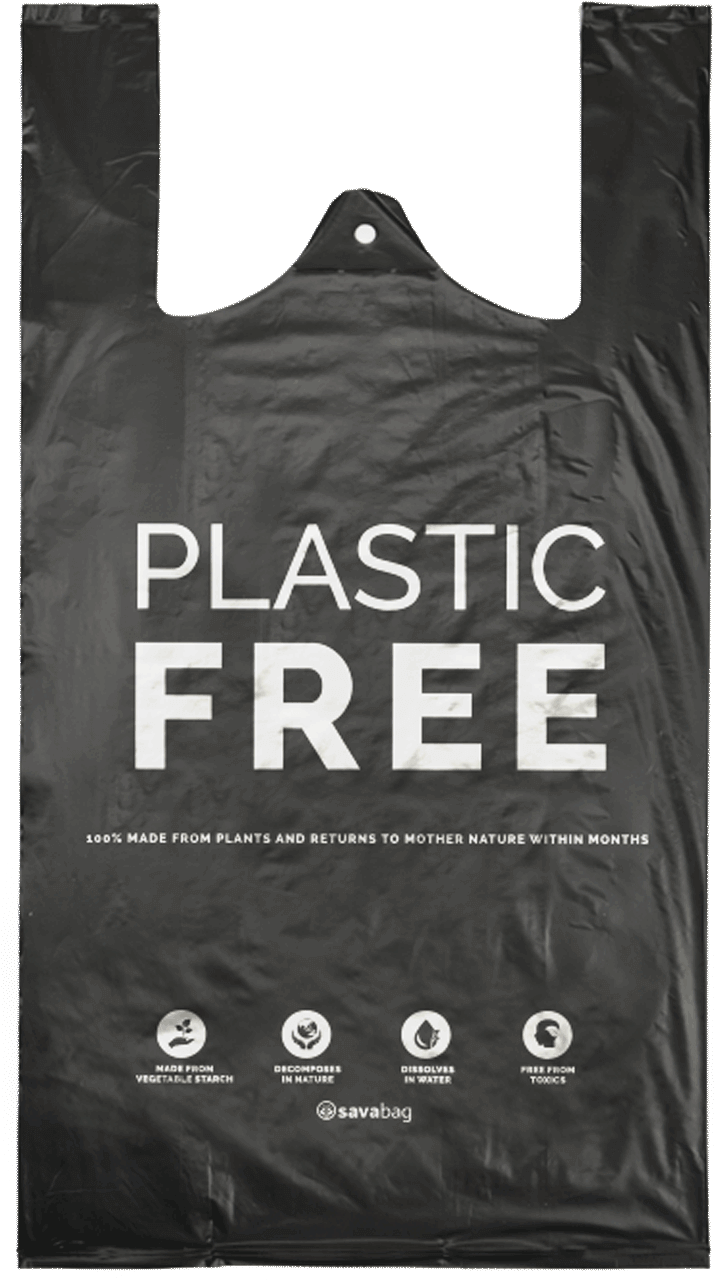
Starch bags - how to use them to make sense of it
A separate bag for a banana, eggs, chicken and two bags for flour and sugar at once (in case something breaks.) - The volume of plastic bags consumed in Ukraine is reaching enormous proportions. Each person throws away at least 2-5 of them every day. Some Ukrainian packaging manufacturers have started to produce biodegradable starch bags that do not end up in landfills for a hundred years, but turn into [...]
Content:
A separate bag for a banana, eggs, chicken and two bags for flour and sugar at once (in case something breaks.) - The volume of plastic bags consumed in Ukraine is reaching enormous proportions. Each person throws away at least 2-5 of them every day. Some Ukrainian packaging manufacturers have begun to produce biodegradable starch bags that do not lie in landfills for a hundred years, but turn into fertiliser in just 3 months. Let's find out how this invention will help solve the problem of polyethylene pollution.
What bags are called "biodegradable"
There are two types of biodegradable bags:
- made of oxo-biodegradable plastic - They are made from traditional plastics that are treated with a special additive that accelerates the breakdown of plastic into small particles. These particles are no larger than 5 mm and are called microplasticwhich pollutes the environment even more than conventional plastic;
- compostable bags (labelled compostable) - They are based on potato or corn starch and biodegradable oil products that are completely absorbed by microorganisms. These bags decompose and turn into natural humus. However, this process requires special conditions: the right temperature and humidity.
It makes sense to buy oxo-biodegradable plastic bags only if you collect them on purpose and then take them to a waste recycling plant. In a landfill, such bags will be no less harmful to the environment than regular ones.
Microplastics are small plastic particles up to 5 mm in size that can be easily transported from place to place and penetrate literally everywhere: water, food, animal, fish and human organisms. They have abrasive properties (damage soft tissue) and absorb various substances, including toxic ones. They get into the environment in various ways: when washing synthetic clothing, through cosmetics (microplastics are added to shampoos, scrubs, shower gels, etc.) and during the decomposition of oxo-biodegradable bags.
The compostable bags are made from 100% biodegradable components. At a certain temperature (ideally +70°C), humidity, bacteria and microorganisms, they break down into biomass, carbon dioxide and water. No microplastics remain. The rate of decomposition depends on where it takes place: in an industrial composter, at home, or simply outdoors. In an industrial environment, it takes 60 days, while at home it takes about 6 months. Without special conditions, this process can take up to 2 years.
Who produces starch packets in Ukraine
There are three manufacturers in our country that produce biodegradable bags made from corn and potato starch. They can be used not only for garbage but also for other household needs. For example, you can store food in them or go to the supermarket with them.
"Novis
"Novis - is a packaging plant located in the city of Dnipro. It started producing bags made from corn starch and biopolymers of plant origin in 2020. Its products have been tested in Europe and have the international OK compost HOME certificate. These bags are composted at home in 30-90 days. They are packed in rolls of 20 and have a volume of 35 litres. The price is still quite high: UAH 59 per 1 roll. Unlike conventional polyethylene bags, these have an expiry date and special storage conditions: 12 months in a dry and preferably dark place.
Biosphere Corporation
Biosphere companies owns the Smile wipes and Freken Bock brand of household cleaning products. In 2020, the manufacturer launched biodegradable Go Green bags, which caused many questions among people. They consist of biopolymers and raw materials of natural origin (corn or potato starch, PLA polylactide) and are biodegradable without residual microplastics. The products comply with the global "bio-based" standard, which confirms that they contain at least 40% of natural raw materials. These bags decompose within 6 months under industrial composting conditions. They have a volume of 35 litres and come in rolls of 10. The price is also high: UAH 59 per 1 roll.
"ChistoPes"
ChistoPes Company is interesting because it does not just produce starch bags, but promotes a very delicate but important topic - cleaning up the excrement of your pets while walking. The brand produces both regular bags and starch bags that are completely biodegradable, breaking down into water, CO2 and biomass (a cocktail of macromolecular organic polymers). Even the paint used to apply the pattern is environmentally friendly. The bags are packaged in packs of 10, 20 and 50. The cost of one pack, depending on the number of sachets inside, is from 30 UAH to 100 UAH.
Aleksandra Shcheglova, co-founder of the ChistoPes brand, told us about the production process:

Co-founder of the brand "ChistoPes"
We buy the raw materials for ChistoPet bags in the European Union. It comes to the production site in the form of granules, which are placed in an extruder for further melting. The result is a transparent, thin, melted material in the shape of a pipe (sleeve). This sleeve is gradually cooled, after which it is rolled out with a roller and cut to make two separate parts. Then an automated robot cuts the film to the required width with a knife, and it is wound into rolls. After production and preparation, the film is sent for further processing.
The raw materials and finished products from it have European-style certificates of conformity and have been certified by the independent body TÜV AUSTRIA. Our bags are also labelled "OK Compost" and comply with EN13432 (this is a GOST that sets out the requirements for the manufacture of packaging that is recycled through composting and biodegradation - editor's note). I would also like to note that the ink we use to apply the print to the bag is also environmentally friendly.
It is very important to understand that if you do not have composting facilities, this does not mean that a bag of starch will not decompose at all and will last for hundreds of years. This is not the case. Even without special conditions, such bags will disappear under the influence of natural factors (sunlight, moisture, soil, air temperature). It will just take more time.
Under industrial composting conditions, ChistoPes bags decompose in 60-90 days, but the employees also tested them on their own: it turned out that in the open air they become less elastic after 3 months and break faster. Another part of the bags was buried in the open ground and left for 9 months. During this time, they completely decomposed, as the remains could not be found.
The products are aimed at dog owners, but the manufacturer claims that they can also be used to store food, including wet food. But to prevent the material from changing its structure prematurely, it is recommended to store them in a dry and sun-protected place.
Is it worth switching from plastic to biodegradable bags?
Each of the three manufacturers says the same thing: corn or potato starch packets decompose within the specified time frame (30-60 days) only in conditions for proper disposal. That is, the conditions created by an industrial composter, which ensures constant high temperature, humidity and free air penetration. In the conditions of a compost pit in the garden, such bags will also decompose, but much more slowly.
Therefore, we had a logical question: does it make sense to buy such bags if they, like all other garbage, go to a landfill, where they are tightly pressed and lie there for years (as, for example, in the case of A newspaper that was taken out of the rubbish heap after 30 yearsThe car is in almost perfect condition).
Here is what the manufacturers themselves have to say about this:

Co-founder of the brand "ChistoPes"
Unfortunately, today in Ukraine there is no practice of separate waste recycling, so even if you throw our bag into a special dog bin, it will end up in a landfill. Of course, such conditions cannot be called ideal for rapid decomposition, but this does not mean that the bag will remain there forever. Unlike regular polyethylene, starch bags need enough humidity and temperature to start the decomposition process.
For such bags to become popular, it is necessary, first of all, to create conditions for the proper recycling of such bags. Introduce a system of separate waste collection, making this process comfortable and familiar to the population. Explain the need to use eco-friendly bags at the state level, and not just by volunteers, as is the case now. Only then will people come to use eco-bags and other eco-products on their own and easily.
We are already taking the first steps, I am talking about the law banning the use of plastic bags. Our company supports this initiative.
Unfortunately, we were unable to contact representatives of other brands, so we will quote their comments in other publications with the sources.
Firstly, the amount of waste will be greatly reduced. Now the landfill means bad smells and a large area. If we start sorting organic and inorganic waste, we will reduce the landfill area by at least two times.
Secondly, inorganic waste will be cleaner because it will not be mixed with food. This is a significant relief for the recycling process, as everything can be used in cycles, and not just once.
Thirdly, we will stop "preserving" household waste in plastic bags for 1,000 years. It will be put back into the ground, and we will grow what we need from it, it will be used as fertiliser.
Andriy Bereza, Head of Novis, in an exclusive interview for press centre of the MOST-Dnipro news agency" to the question of how biodegradable garbage bags will help improve the situation at landfills.
Such a bag will not decompose on the garden heap. This type of composting requires appropriate equipment - a plant. In general, such bags cannot be released into nature; let's think about disposing of such bags exclusively at special anaerobic composting plants. There are still no industrial composting plants in Ukraine - these questions should be addressed to the central executive authorities and local authorities. The manufacturer is powerless here.
Yevheniia Aratovska, founder of the organisation "Ukraine Without Waste" on biodegradable starch bags.
Our conclusion.
To make starch bags really useful, you need to use them properly. Have 2 bins at home instead of just one, separate the garbage and throw it into the appropriate bins. Put bottles with glass, paper with waste paper, disposable tableware, packaging and other plastics with plastic, and organics with mixed waste.
In our country, there are no plants where organic waste is processed on an industrial scale, but provided that you throw away only organic waste in such a bag, it will still be very useful: it will turn into humus by itself and will not interfere with the decomposition of the food waste inside it.
Where to use bioresorbable bags:
- in the country or in the village - you can put it in a compost heap or bury it in the ground;
- at home to store food;
- at work (you can carry sandwiches or buns in them);
- in the store - instead of regular plastic bags.
It also makes sense to use oxo-biodegradable bags. Even though they break down into microplastic. You also need to do it correctly: collect them and, when a large amount is generated, take them to the plant and recycle them.






